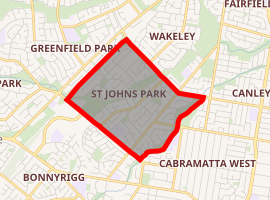St Johns Park, New South Wales
St Johns Park is a suburb of Sydney, in the state of New South Wales, Australia 35 kilometres west of the Sydney central business district, in the local government areas of the City of Fairfield. It is part of the Greater Western Sydney region.
| St Johns Park Sydney, New South Wales | |||||||||||||||
|---|---|---|---|---|---|---|---|---|---|---|---|---|---|---|---|

| |||||||||||||||
| Population | 5,961 (2016 census)[1] | ||||||||||||||
| Postcode(s) | 2176 | ||||||||||||||
| Location | 35 km (22 mi) west of Sydney CBD | ||||||||||||||
| LGA(s) | City of Fairfield | ||||||||||||||
| State electorate(s) | Cabramatta | ||||||||||||||
| Federal Division(s) | Fowler | ||||||||||||||
| |||||||||||||||
History
St Johns Park was originally home to the Cabrogal people who inhabited the broad Liverpool-Fairfield area. When the First Fleet arrived in Australia, the colonial administration designated this area the parish of St John. Nineteenth century maps indicate a St Johns Farm in the area and it is through this connection that the suburb gained its name.[2]
By the 1890s there was a public school on Parkes Road (now Edensor Road), a post office (opened in 1888), and a growing community, with an unusual number of Italians, who had arrived in the 1880s after the failure of the Marquis de Rays's expedition to New Ireland. The Bellotti and Gava families established vineyards on Bulls Road.
Yugoslav migrants Theodore and Samuel Serovich arrived in 1885, also cultivating wine grapes.
Both the Italian and Yugoslav communities were renewed and expanded during the period of postwar migration in the 1940s, and St Johns Park is still a very multicultural area. Members of the Gava and Serovich families still live in the area. Chicory and wild fennel growing along the banks of Clear Paddock Creek are relics of the early European farmers.[3]
People
According to the 2016 census, St Johns Park had a population of 6,119 people with a median age of 41, which was higher than the national median age of 38. Over a third of people were born in Australia (39.3%), with the other most common countries of birth being Vietnam (17.5%), Cambodia (5.7%), Iraq (5.2%), Croatia (3.7%) and Laos (2.1%). The majority of people spoke a language other than English at home (82.0%), with Vietnamese (23.7%), Cantonese (6.3%), Croatian (5.5%), Assyrian Neo-Aramaic (4.5%) and Khmer (4.4%) forming the top responses for languages spoken at home. About a fifth of people (21.2%) spoke only English at home.[1]
Housing
At the time of the 2016 census, St Johns Park had a total of 1,660 occupied private dwellings, of which 93.1% were separate houses, 6.4% were semi-detached dwellings and 0.4% were flats or apartments. Of these occupied private dwellings, 50.1% were owned outright, 29.6% were owned with a mortgage and 17.2% were rented.[1]
Landmarks
St Johns Park sits beside Clear Paddock Creek which runs along 500m. The 'Restoring the Waters' project, which was the first of its kind in Australia, consisted of the restoration of the concrete channel into a living stream. It took seven years to plan and build and was funded with the assistance of a $1.33 million grant from the NSW State Government through its Stormwater Trust.[4]
Schools
- St Johns Park Public School
Places of worship
- St James Smithfield
- St Johns Park Baptist Church [5]
- St Nikola Tavelic Croatian Catholic Church and Community Centre
- St Hurmizd Assyrian Church Of The East Cathedral
- Buddhist Phap Bao Temple
Clubs
- St Johns Park Bowling Club
- St Johns Park Sports Club (also known as Jadran Hajduk Croatian Club).
Services
- Cardinal Stepinac Village is a retirement hostel and nursing home
References
- Australian Bureau of Statistics (27 June 2017). "St Johns Park (State Suburb)". 2016 Census QuickStats. Retrieved 27 June 2017.

- "St Johns Park". Fairfield City Council. Retrieved 12 June 2008.
- Vicki Movizio (2011). "St Johns Park". Dictionary of Sydney. Dictionary of Sydney Trust. Retrieved 5 December 2011.
- "Restoring the waters". Fairfield City Council. Retrieved 12 June 2008.
- "St Johns Park Baptist Church (Bible Baptist Church)".